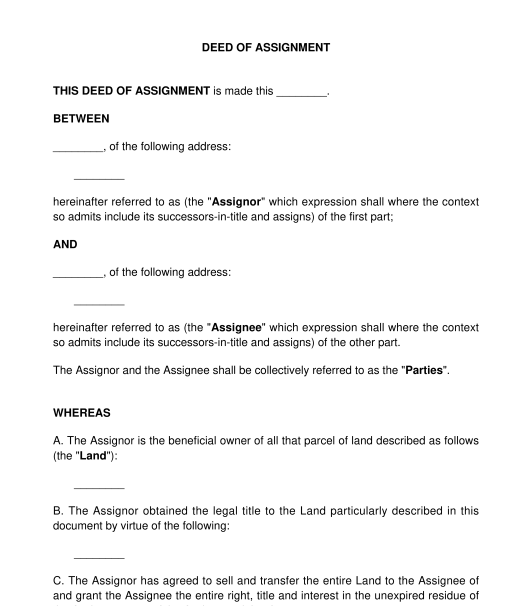 11/10/2025
11/10/2025

Answer a few questions and your document is created automatically.

Your document is ready! You will receive it in Word and PDF formats. You will be able to modify it.

 11/10/2025
11/10/2025
 Word and PDF
Word and PDF
 4 to 5 pages
4 to 5 pages



A Deed of Assignment is an instrument of transfer which is used in real estate transactions to transfer legal title or the ownership of a land or building from the title holder (called the assignor) to another person (called the assignee), usually for a consideration (money or money's worth).
In a contract of sale of real property, the title transfer is done in writing, signed, sealed and delivered by the parties to the transaction.
This is a very important document that should be delivered to the purchaser after the conclusion of the sale of any real property.
The contract of sale and a deed of assignment are vital documents in real property sale and purchase transactions.
However, a contract of sale alone does not transfer ownership or interest in real property. On the other hand, a registered deed of assignment not only transfers legal interest in real property but also serves as the assignee's root of title. This means that a registered deed of assignment serves as proof of ownership of real property.
Yes, a deed of assignment is required as it typically needs to be registered with the Land Registry.
The following are the essential components of a deed of assignment:
The parties to a deed of assignment are the assignor and the assignee. The assignor is the party that owns title to the property they are transferring to the assignee. The assignee, on the other hand, becomes the new title holder of the property transferred under the deed of assignment.
Generally, minors (persons who are below the age of 18 years) cannot validly enter a binding contract, including a deed of assignment.
If the assignee is a minor, the legal guardian of the minor should sign the deed of assignment on behalf of the minor.
After signing the four copies of the deed of assignment:
After signing and notarization:
The following should be attached to a deed of assignment for registration at the Land Registry:
Yes, all original copies of the deed of assignment should be notarized before registration.
Notarization happens when a notary public certifies the authenticity of a document by placing a seal and signing the document.
Yes, it is necessary to register the deed of assignment at the requisite Land Registry, as registration serves as evidence of ownership of title.
Yes, the deed of assignment needs to be witnessed to be valid. After the parties have signed, the deed of assignment should be witnessed by at least one person. The witness is required to hand fill in their names, addresses, and occupations and also sign the deed of assignment.
The cost of finalizing a deed of assignment varies, particularly a deed of assignment intended for the transfer of real property, as it includes the cost of notarization, registration, the requisite taxes, and attorney fees.
It is important to consult the Land Registry for updated details of the cost.
After registration of the deed of assignment, the title of the real property is transferred to the assignee. However, the assignee is not necessarily referred to as the owner but the title holder.
This is because under the Land Use Act, all state and federal lands are vested in the governor of each state and the federal government respectively, who hold the lands as trustees for Nigerians. Consequently, a person who acquires ownership of land in Nigeria is granted a certain term of years (usually 99 years) and is not referred to as the owner but the holder of a term of years and can assign the remainder of such term to another under a deed of assignment.
The Land Use Act of 1978 applies to the deed of assignment. The Property and Conveyancing Law of 1959, Lagos State Registration of Titles Law 2004 and the Registration of Titles laws of various states are also applicable to the deed of assignment.
You fill out a form. The document is created before your eyes as you respond to the questions.
At the end, you receive it in Word and PDF formats. You can modify it and reuse it.
A guide to help you: How to Acquire Real Property in Nigeria
Deed of Assignment - FREE - sample template
Country: Nigeria